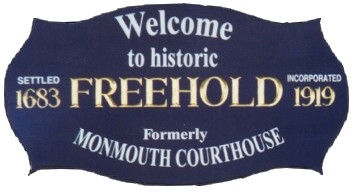The rug mill still haunts Freehold
By KEVIN COYNE
After they got the bad news, some of the workers gathered on the sidewalk outside the company's doors, their faces fixed with the stunned and bitter expression of people who have just been told they are no longer wanted.
"It was an awful shock," one man told a reporter from the local newspaper. "I'm very worried about the future. It's rough having to think about looking for a job at my age".
"I don't think it's fair to men with 35 years or more of loyal service to men with financial commitments and families to bring up," said another.
It is a distressingly familiar scene these days, played out at businesses large and small, as payrolls are cut and employees are downsized out of the jobs they had hoped to retire from. But when these workers lost their jobs, it was the week before Thanksgiving in 1960, and the company that was laying them off was the A&M Karagheusian rug mill in Freehold. The spot where they collected then to talk to a Freehold Transcript reporter is the same spot where more than 100 firefighters converged last week to battle the latest blaze in the now vacant mill building.
Last week's fire started amid some wood pallets and paper up on the third floor of the mill, but its true origins reach back to that gray November day when 150 broadloom weavers learned that their jobs were moving to North Carolina. Over the next three years, all the rest of the jobs in the rug mill moved south, too leaving behind a gaping hole in the local economy, and a vast, looming factory building that stands now as both a memory and a warning. The story of the mill's sad decline in the years since the shutdown offers both a cautionary tale about what happens when a company breaks the social contract that binds it to a community, and an omen about what fires we might be fighting in the decades that follow the current round of corporate downsizing.
A&M Karagheusian moved into an old shirt factory on Jackson Street in Freehold in 1904 and set up shop with some looms and weavers imported from England. It grew steadily, building more factory space as it marched north up the street, until it became the fourth-largest rug manufacturer in the country. By the 1940s, it had about 1,800 workers, drawn from almost every family in town, my own included. The mill was deeply woven into the fabric of the community, in a pattern as rich and complex and intricate as any of the prized Gulistan Orientals it turned out.
"In most instances, (rug factories) are the chief support of the immediate communities," wrote Henry Grasberger, a mill foreman and my uncle's father, in a 1940 monograph about the industry, "which are among the beauty spots of the country villages and towns of modest but substantial homes, well-kept green lawns, quiet shady streets, fine schools and churches."
The fiddle-patterned rug that Karagheusian made for Radio City Music Hall was so sturdy that 55 million pairs
of feet tramped across it before a replacement was ordered from Karagheusian again, of course. Karagheusian rugs
covered the floors of hotels and department stores, ocean liners and luxury trains, and of most homes in Freehold.
(There are still two in mine,) The justices of the U.S. Supreme Court walked across a Karaghueusian rug when they
took the bench. Jean Harlow ordered a platinum rug to match her hair, a lock of which she sent along as a color guide.
But by the late 1950s, the world was changing, and the mill wasn't keeping pace. International competition grew stronger. New technologies were emerging allowing tufted carpet to be manufactured by the mile by less-skilled workers, rather than woven by the yard by Freehold's practiced craftsmen. The South beckoned with cheap land and cheap labor. Today, 90 percent of all the carpet sold in the United States is made within 100 miles of Dalton, Georgia.
Most of the laid-off workers eventually found other jobs, but few were able to fully replace either the paycheck or the sense of stability and continuity they had gotten at the mill. The wounds stayed open for years. My grand- father, who never met a stranger and had unkind words for no one, practically spat with bitterness when he spoke of the mill, He had no pension to show for his 32 years there, only a tiny brass service pin engraved with a winged hourglass.
The downtown business district went into a prolonged swoon: the "whitewashed windows and vacant stores" of Bruce Springsteen's "My Hometown." Other smaller companies moved in and out of the cavernous space the mill left behind, but none came close to matching its size or impact.
The rug mill's glowering five-story bulk has so far resisted all the attempts to stitch it back into the town's fabric. Not even Springsteen could help: His $100,000 check didn't spark the redevelopment it was meant to, and was instead used to buy a new fire truck for the department that extinguished last week's blaze.
But the mill has also resisted the efforts by nature, neglect and accident to bring it down. Built solidly of steel and concrete, it is so sturdy, according to Borough Administrator Bob Casey, "you could drop bombs on it and it wouldn't fall down." The flames leaped toward the sky Jan. 25, but the walls stood fast. An ambitious plan for its rebirth remains in the works - offices, stores, apartments - awaiting the right combination of money, interest and will.
The rug mill stands there now - the hollow wind blowing through its broken windows and across its empty floors as a defiant reminder that you can't make promises and then break them without consequences. And the stronger those promises are, the battered old building says, the longer they will follow you through this world.

